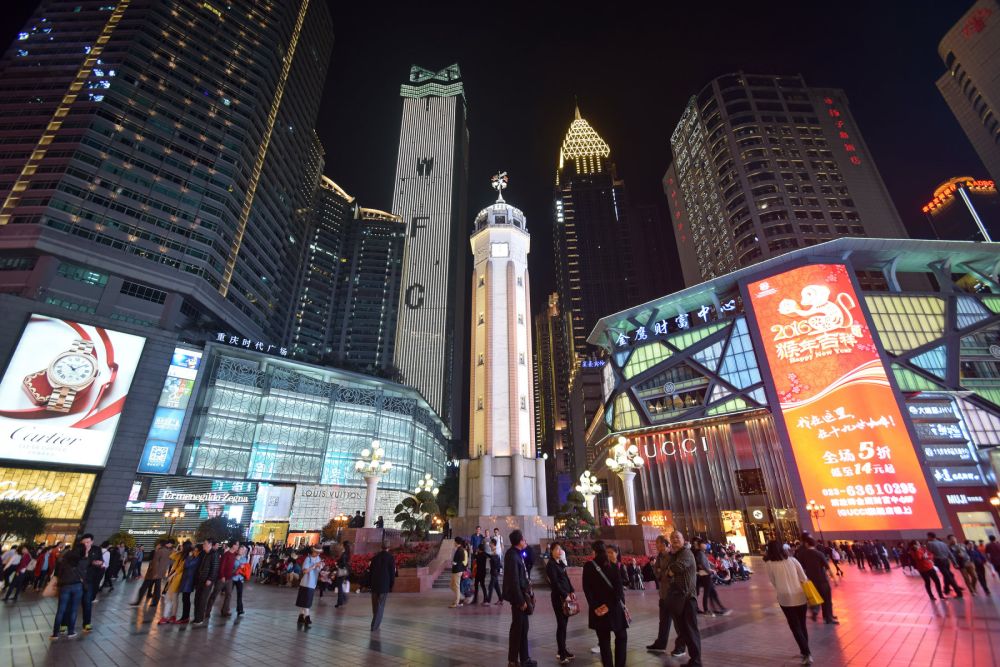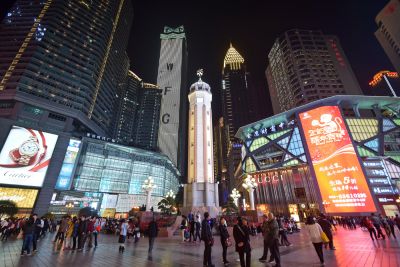

The Jiefangbei Shopping District, located at the heart of Chongqing, offers a vibrant and bustling atmosphere where visitors can immerse themselves in top-notch retail therapy. Spanning across several blocks, this area is adorned with a myriad of shops ranging from high-end fashion boutiques to unique local brands that cater to all tastes and preferences. As you stroll along the pedestrian street, you'll notice the towering Monument of Liberation, an iconic symbol of the city's wartime history. Apart from the shops, the area is dotted with a variety of restaurants where you can indulge in Chongqing's famous spicy cuisine, including hotpot and street snacks. The ambiance is especially captivating at night when the neon lights illuminate the skyline, creating a visual feast that is quintessentially urban China.
There's no better place to experience the fiery sensation of Chongqing hotpot than in the bustling environs of Jiefangbei Pedestrian Street. Hotpot restaurants here range from traditional establishments with history to contemporary spots with trendsetting flavors. Patrons can select their preferred broth, which typically comes as a spicy Sichuan-style soup or a milder version for those less inclined toward intense heat. A cornucopia of ingredients including thinly sliced meats, fresh vegetables, tofu, and noodles are then cooked tableside in the boiling pot. The interactive dining experience is further enhanced by a wide selection of dipping sauces to complement the cooked morsels. It's not only a meal; it's an essential culinary adventure that speaks to the heart of Chongqing's culture.
A short walk from the dizzying commercialism of Jiefangbei Pedestrian Street, you can find spiritual solace at the serene Arhat Temple. Known locally as Luohan Si, this Buddhist temple dates back over a thousand years and is home to an impressive collection of nearly 500 arhat statues, each with a unique expression and posture. The craftsmanship is exquisite, highlighting the skill of ancient sculptors. A visit to the temple offers a glimpse into Buddhist culture, providing a tranquil contrast to the pulsating streets nearby. Upon entering, the scent of incense and the calming chants of monks provide a peaceful retreat for contemplation and reflection. Exploring the temple complex's various halls and courtyards, you're bound to feel a connection to Chongqing's rich tapestry of history and spirituality.
Jiefangbei Square, the heart of downtown Chongqing, is a prime spot to enjoy the city's dazzling nocturnal panorama. As the sun sets, the buildings surrounding the square light up in a spectacular fashion, showcasing a mesmerizing array of colors that reflect off the Yangtze River. The landmark Liberation Monument, standing tall at the center, becomes the focal point amidst the hustle and bustle of the metropolis. Visitors can take a leisurely walk around the square to admire the surrounding skyscrapers, or find a café with outdoor seating to absorb the vibrant urban atmosphere. It’s a perfect place to capture photos of the city’s skyline or to simply revel in the energetic pulse of one of China's booming urban centers.
Hongya Cave is an architectural wonder, perched along the riverside and offering a delightful mix of commercial, cultural, and dining experiences. Built into the side of a cliff, this multi-level complex is designed in the traditional stilted building style (Diaojiaolou) akin to that found in many of China's ancient towns. Visitors can wander through its many levels, encountering shops selling handicrafts, local snacks, and souvenirs, as well as restaurants with mouthwatering menus. The top floors also present an arresting view of the river and the city skyline. At night, the entire structure is vividly illuminated, turning it into a breathtaking specter that seems to rise directly from the water. Hongya Cave is a brilliant juxtaposition of the old and new, reflecting Chongqing's respect for tradition amid its modern development.
For food enthusiasts, Bayi Road Delicious Street is a culinary heaven within the Jiefangbei area. This street is famed for its wide array of street food stalls and small eateries offering an extensive selection of snacks and dishes that are quintessentially Chongqing. It's an excellent place to savor local specialties such as the spicy and numbing Chongqing noodles, succulent skewered meats, and the famous Sichuan cold noodles. Crowds flock here not just for the food but also for the spirited and joyful street food ambiance it provides. Each stall has its own secret recipes and homemade sauces that contribute to an unforgettable taste sensation. It's a wonderful opportunity to engage with locals and experience the true grassroots food culture of the city.
Situated close to the Jiefangbei district, The Three Gorges Museum offers a deep dive into the natural history and cultural heritage of the region surrounding the Yangtze River. The museum's extensive exhibits take visitors on a historical journey from ancient times to the modern era, with a significant focus on the construction of the Three Gorges Dam, a marvel of modern engineering. Here, you can explore artifacts, traditional clothing, and interactive displays that educate about the biodiversity and geography of the Three Gorges area. Additionally, the museum provides context to Chongqing’s role in China's wartime history, serving as the provisional capital during the Second Sino-Japanese war. It's an enriching visit for those who wish to comprehend the profound impact of the river on the development and identity of Chongqing.
A Yangtze River cruise starting from the Chaotianmen Dock near Jiefangbei is a paramount experience for any visitor to Chongqing. These cruises offer splendid views of the city's skyline, allowing passengers to witness the juxtaposition of old colonial architecture with soaring modern towers. As the boat glides along the river, one can marvel at the majestic bridges and get an unobstructed perspective of the iconic Hongya Cave. Cruises may range from short sightseeing trips to longer excursions that venture farther afield, where the dramatic landscape of the Three Gorges takes center stage. Whether by day or illuminated by city lights at night, a cruise here is a chance to unwind and appreciate the beauty and significance of the Yangtze to Chongqing.
Embarking on a guided walking tour of the Jiefangbei district and surrounding areas is an exclusive way to embrace the essence of Chongqing. Knowledgeable guides can unveil the stories behind the city’s landmarks, delve into the local culture, and navigate the labyrinth of streets to reveal hidden gems not easily discovered by solo travelers. Highlights of such tours include architectural wonders, cultural sites, and the opportunity to partake in local delicacies. Additionally, visitors have the chance to interact with local merchants and artisans, providing an intimate and authentic view of life in Chongqing. This activity not only promotes physical well-being through walking but also engages the mind with historical insights and cultural understanding.
A visit to Chongqing would be incomplete without spending time in a traditional tea house. Nestled within the hustle and bustle of Jiefangbei, these quaint establishments serve as social hubs where locals gather to sip tea, engage in spirited conversation, play games, or simply relax. The atmosphere in a Chongqing tea house is a mix of homeliness and nostalgia; it is here where you can experience the legendary Sichuan opera 'face-changing' performances or the mesmerizing sound of local musicians practicing the erhu. Visitors can choose from a variety of teas, from robust and malty black teas to delicate greens and oolongs. Engaging with this age-old pastime offers a tranquil respite from the city's frenetic pace and provides insight into the daily rituals that define Chongqing's cultural fabric.
